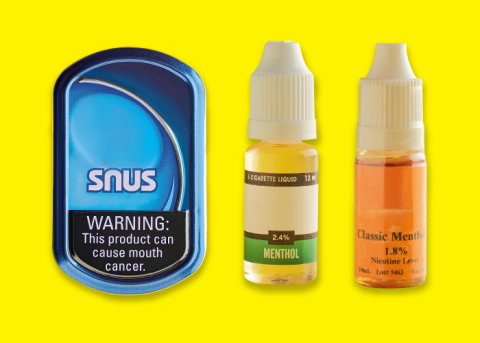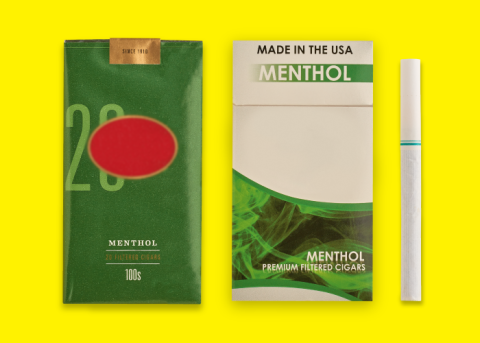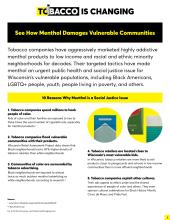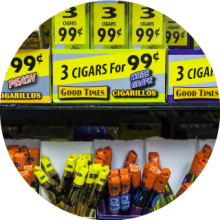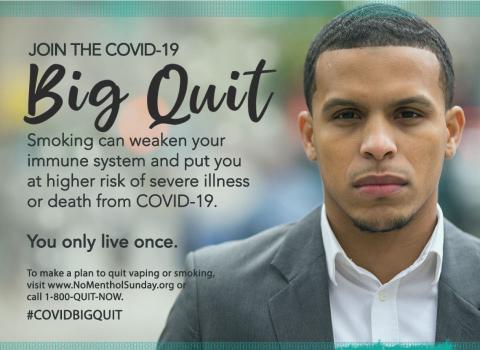Tobacco is Changing: Menthol
Tobacco's first flavor is its most addictive
Menthol cigarettes might be considered the original, flavored tobacco product. Tobacco companies have been marketing the minty flavor’s cooling sensation to first-time tobacco users since the ingredient was introduced to tobacco products in the 1920s. Menthol can cool and soothe the harshness of tobacco, which may explain why menthol cigarette use is higher among young people than older adults. Sadly, kids who experiment with menthol tobacco products may be more likely to develop a lifelong addiction. That’s because the Food and Drug Administration (FDA) has determined that menthol actually makes tobacco products more addictive and harder to quit.
Despite its dangerously addictive effects, menthol has been left out of new federal laws that restrict flavored tobacco products. While the FDA has limited the use of trendy flavor names like “Fresh Mint” and “Ice” for some types of flavored e-cigarettes, adding menthol to the tobacco products youths like most is still legal.
What to look for
Menthol has made it into almost every type of tobacco product there is, including electronic smoking devices and e-liquids, smokeless tobacco, and cigar products.
Using menthol to target minority communities
Menthol has a long history of being marketed to African American communities. It’s still a common practice in low income and racial or ethnic minority neighborhoods, exposing kids of color and their families to two to three times the usual number of cigarette ads, especially for menthol products.
Tobacco’s deliberate marketing efforts are working. Nationally, 70.5 percent of African American middle and high school students who report smoking use menthol cigarettes, compared to 51.4 percent of white students. The consequences? Lifelong addiction and the serious, often deadly, health effects of tobacco use are spreading from one generation to the next in Wisconsin’s communities of color.
Other vulnerable communities are being damaged too. Due to industry targeting, and the toxic stress that members of minority populations can experience, tobacco use disproportionately impacts racial and ethnic minorities, women, people who earn less, or experience homelessness, and those living with mental or behavioral health challenges. Research shows LGBTQ+ youth smoke at higher rates than the national average.
Hit play to learn more about the tricky tobacco industry tactics that have made menthol products an urgent social justice issue for vulnerable populations, including youth, African-Americans, LGBTQ+ people, people living in poverty, and others in Wisconsin.
How they do it
They target neighborhoods
Tobacco companies are flooding low income and racial and ethnic minority communities with flavored products loaded with highly addictive menthol, like little cigars, menthol cigarettes, and vapes. Research shows a menthol ban could save as many as 340,000 American lives—including at least 100,000 black lives—by 2050.
They sell near schools
Tobacco companies work hard to get their tricky retail environment tactics as close to kids as possible. Throughout Wisconsin, and across our country, tobacco retailers are more likely to sell products closer to playgrounds and schools in low-income communities than in more affluent neighborhoods. Data from the 2016-2018 Wisconsin Retail Assessment Project showed that Black neighborhoods had a 50 percent higher density of tobacco retailers than white neighborhoods.
They slash prices
In-store tobacco marketing is out of control, especially in minority and low-income communities. Tobacco companies aggressively advertise menthol products in and around neighborhood retailers, offering huge price promotions to attract budget-minded users like kids. Data from the 2016-2018 Wisconsin Retail Assessment Project showed there are almost twice as many menthol price promotions in Black neighborhoods as white neighborhoods.
They tap into the culture
Black neighborhoods are exposed to almost twice as much outdoor menthol advertising as white neighborhoods, according to research. The tobacco industry drives menthol’s popularity with marketing that appeals to ethnic pride and the shared experiences of people of color, and other vulnerable populations. They even sponsor cultural events, like celebrations for Black History Month, Cinco de Mayo, Pride Fest, and more.
You should know
Menthol tobacco products are not safe. With names like smooth, cool, skyline, ice, crisp blend, and fresh mint, menthol tobacco products can give kids the impression that menthol products are safer, or milder, versions of conventional tobacco, but no tobacco product is safe. Menthol suppresses coughing and the flavor helps hide tobacco's chemicals and harsh taste.
Menthol tobacco products are highly addictive. Menthol can make cigarettes more addictive and harder to quit. Menthol smokers report shorter periods between cigarettes. They also try to quit smoking more often and are less likely to be successful.
Menthol cigarettes harm nearly every organ in the body. Smoking menthol cigarettes exposes your body to thousands of chemicals, including poisons like arsenic, and nearly 70 known cancer causers. It can damage your heart, blood vessels, lungs, eyes, mouth, reproductive organs, bones, bladder, and digestive organs. It can also change the way a young person's brain develops.
Resources
Learn more about menthol tobacco products the harm they can do:
- No Menthol Sunday Virtual Kick-off
- No Menthol Sunday sample resources
- The Truth about Menthol
- Preliminary Scientific Evaluation of the Possible Public Health Effects of Menthol Versus Non-Menthol Cigarettes
- Point of Sale Tobacco Marketing
- Tobacco Use Among African Americans (PDF)
- Chemicals in Cigarettes: From Plant, to Product, to Puff
- Health Effects of Cigarette Smoking
See the damage menthol can do
When you know the facts, it’s easy to see why the tobacco industry’s menthol products and marketing tactics have become an urgent social justice issue for vulnerable communities and their allies throughout Wisconsin. Download the See How Menthol Damages Vulnerable Communities fact sheet, P-02040c, to learn:
- How menthol makes tobacco easier to use and harder to quit
- Who is being targeted by the tobacco industry’s menthol marketing tactics
- How menthol products get close to WI kids, schools, and neighborhoods
Different tactics, same threat
Understand all the ways tobacco companies scheme to make, package, and market products that can lock down the next generation of lifelong tobacco users.
Support comprehensive flavor restrictions that include menthol
Menthol may be the most addictive flavor added to tobacco products, but it is often deliberately left out of restrictions that govern the flavored tobacco products that tempt kids. You can help change that. Find out how you can support comprehensive best practice tobacco policies for a healthier state and take action in your own community.
Take the next step
Change for the better starts when caring individuals stand together for kids, their communities, and policies that can improve everyone’s health. Find out how you can make a difference.


